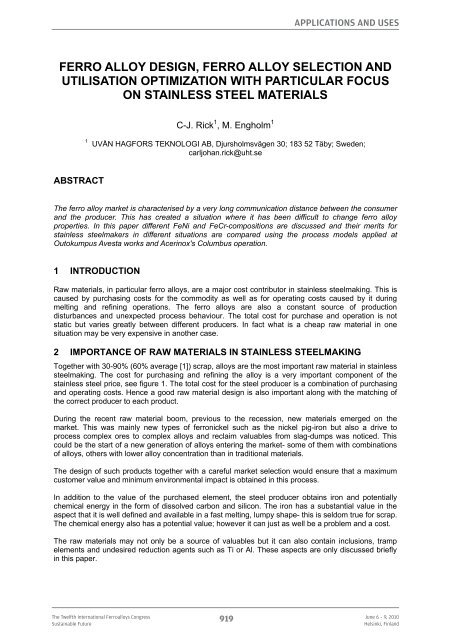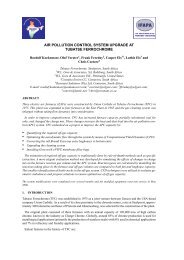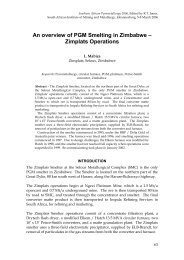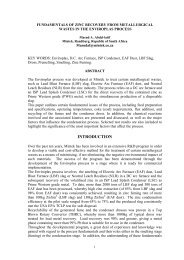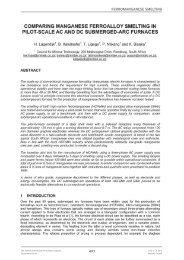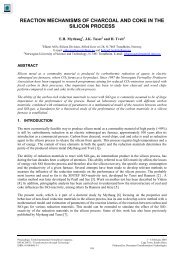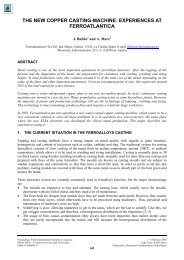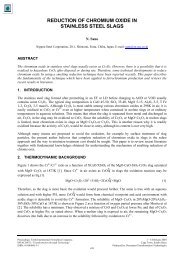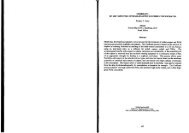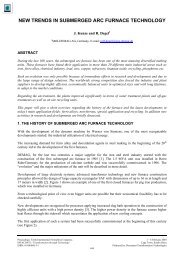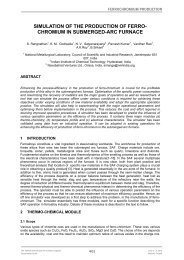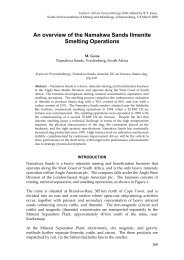ferro alloy design, ferro alloy selection and utilisation ... - Pyro.co.za
ferro alloy design, ferro alloy selection and utilisation ... - Pyro.co.za
ferro alloy design, ferro alloy selection and utilisation ... - Pyro.co.za
- No tags were found...
Create successful ePaper yourself
Turn your PDF publications into a flip-book with our unique Google optimized e-Paper software.
Applications <strong>and</strong> UsesFERRO ALLOY DESIGN, FERRO ALLOY SELECTION ANDUTILISATION OPTIMIZATION WITH PARTICULAR FOCUSON STAINLESS STEEL MATERIALSC-J. Rick 1 , M. Engholm 11 UVÅN HAGFORS TEKNOLOGI AB, Djursholmsvägen 30; 183 52 Täby; Sweden;carljohan.rick@uht.seABSTRACTThe <strong>ferro</strong> <strong>alloy</strong> market is characterised by a very long <strong>co</strong>mmunication distance between the <strong>co</strong>nsumer<strong>and</strong> the producer. This has created a situation where it has been difficult to change <strong>ferro</strong> <strong>alloy</strong>properties. In this paper different FeNi <strong>and</strong> FeCr-<strong>co</strong>mpositions are discussed <strong>and</strong> their merits forstainless steelmakers in different situations are <strong>co</strong>mpared using the process models applied atOutokumpus Avesta works <strong>and</strong> Acerinox's Columbus operation.1 INTRODUCTIONRaw materials, in particular <strong>ferro</strong> <strong>alloy</strong>s, are a major <strong>co</strong>st <strong>co</strong>ntributor in stainless steelmaking. This iscaused by purchasing <strong>co</strong>sts for the <strong>co</strong>mmodity as well as for operating <strong>co</strong>sts caused by it duringmelting <strong>and</strong> refining operations. The <strong>ferro</strong> <strong>alloy</strong>s are also a <strong>co</strong>nstant source of productiondisturbances <strong>and</strong> unexpected process behaviour. The total <strong>co</strong>st for purchase <strong>and</strong> operation is notstatic but varies greatly between different producers. In fact what is a cheap raw material in onesituation may be very expensive in another case.2 IMPORTANCE OF RAW MATERIALS IN STAINLESS STEELMAKINGTogether with 30-90% (60% average [1]) scrap, <strong>alloy</strong>s are the most important raw material in stainlesssteelmaking. The <strong>co</strong>st for purchasing <strong>and</strong> refining the <strong>alloy</strong> is a very important <strong>co</strong>mponent of thestainless steel price, see figure 1. The total <strong>co</strong>st for the steel producer is a <strong>co</strong>mbination of purchasing<strong>and</strong> operating <strong>co</strong>sts. Hence a good raw material <strong>design</strong> is also important along with the matching ofthe <strong>co</strong>rrect producer to each product.During the recent raw material boom, previous to the recession, new materials emerged on themarket. This was mainly new types of <strong>ferro</strong>nickel such as the nickel pig-iron but also a drive toprocess <strong>co</strong>mplex ores to <strong>co</strong>mplex <strong>alloy</strong>s <strong>and</strong> reclaim valuables from slag-dumps was noticed. This<strong>co</strong>uld be the start of a new generation of <strong>alloy</strong>s entering the market- some of them with <strong>co</strong>mbinationsof <strong>alloy</strong>s, others with lower <strong>alloy</strong> <strong>co</strong>ncentration than in traditional materials.The <strong>design</strong> of such products together with a careful market <strong>selection</strong> would ensure that a maximumcustomer value <strong>and</strong> minimum environmental impact is obtained in this process.In addition to the value of the purchased element, the steel producer obtains iron <strong>and</strong> potentiallychemical energy in the form of dissolved carbon <strong>and</strong> sili<strong>co</strong>n. The iron has a substantial value in theaspect that it is well defined <strong>and</strong> available in a fast melting, lumpy shape- this is seldom true for scrap.The chemical energy also has a potential value; however it can just as well be a problem <strong>and</strong> a <strong>co</strong>st.The raw materials may not only be a source of valuables but it can also <strong>co</strong>ntain inclusions, trampelements <strong>and</strong> undesired reduction agents such as Ti or Al. These aspects are only discussed brieflyin this paper.The Twelfth International Ferro<strong>alloy</strong>s CongressSustainable Future919June 6 – 9, 2010Helsinki, Finl<strong>and</strong>
Applications <strong>and</strong> Uses4 RAW MATERIALS EVALUATED1.2 GeneralFor the discussions in this paper a number of raw materials was selected. Some of them exists asbulk <strong>alloy</strong>s <strong>and</strong> some of them are available or have been projected as a <strong>co</strong>nsequence of refining or byreduction of <strong>co</strong>mplex ores, see table 1. These particular <strong>alloy</strong>s were selected because they <strong>co</strong>ver awide range of properties.Table 1:Alloys used for evaluation <strong>and</strong> discussionHC FeCrCh. CrLC FeCr2Cr22ElementC 7 7 0,1 0,02 0,02 0,04 2 0,04 0,1 0,05Cr 70 50 70 22 11 0 0 0 0 18Si 2 4 2 0,5 0,5 0,3 2 0,06 0,1 0,5Ni 0 0 0 0 11 15 35 99,9 0 8Fe 21 39 27,9 77,5 77,48 84,66 61 0 99,8 73,45CrNiFeNi15FeNi35NiPlFe ScrapN. ScrapIn this table only C, Cr, Si, Ni <strong>and</strong> Fe are <strong>co</strong>nsidered. P, S <strong>and</strong> a number of other elements are alsoimportant in applicability <strong>and</strong> pricing of the materials. In terms of operating <strong>co</strong>sts for the steelmakerthese main elements are the most important ones as other elements rather limits if a material can beused at all.One basic assumption in this paper is that scrap is an equal alternative to the <strong>ferro</strong> <strong>alloy</strong> <strong>and</strong> that keyelements have an equal value <strong>and</strong> price in different raw materials. This is not always the case; thescrap is often not available in a format suitable for bulk h<strong>and</strong>ling <strong>and</strong> may need further treatment forup to 150 euro/ton before it can be added into the <strong>co</strong>nverter. On the other h<strong>and</strong>, the scrap normally<strong>co</strong>mes with a significant element dis<strong>co</strong>unt <strong>co</strong>mpared to the <strong>ferro</strong> <strong>alloy</strong>s.1.3 YieldIn terms of yield for value elements in <strong>alloy</strong>s <strong>and</strong> scrap, there is a significant difference appearingbased on where the additions are made in the process-chain, see figure 3. Normally the yieldimproves the later in the process the addition is made. For Cr the yield may be as low as 90% in anEAF while it is above 99.5% in a ladle while for Ni the yield difference can range between 96-99.9%.This means of <strong>co</strong>urse there is always a drive to make additions as late as possible in the processchain without <strong>co</strong>mpromising quality of the product <strong>and</strong> without being forced to use expensive <strong>alloy</strong>s. Inthis paper no effort was made to model or even to <strong>co</strong>nsider this aspect.1.4 Environmental impactHigh levels of carbon <strong>co</strong>mbined with high levels of sili<strong>co</strong>n means that surplus reduction power isavailable during a refining process. This cannot be utilized in most situations <strong>and</strong> the <strong>co</strong>mbinationthen be<strong>co</strong>mes a mismanagement of precious resources <strong>and</strong> should be avoided. It generates surplusslag, longer processing time, increased lining wear which all means that an increased environmentalfootprint is made by the process. In a melting furnace it is different <strong>and</strong> the high sili<strong>co</strong>n <strong>and</strong> carbonlowers the melting point <strong>and</strong> decrease the metal losses to the slagA particular problem with surplus sili<strong>co</strong>n in the refining is that it does not only increase the slagamount generated by the use of the product but also metal losses. Thus a lower metallurgical yield ofthe process is a <strong>co</strong>nsequence of increased sili<strong>co</strong>n. This effects chromium <strong>and</strong> manganese more thanother elements as small amounts of their oxides normally are lost to the slag. But it also decreasesthe loss of noble metals such as nickel <strong>and</strong> molybdenum as metal droplets <strong>and</strong> spillage also willincrease when much slag is h<strong>and</strong>led.The Twelfth International Ferro<strong>alloy</strong>s CongressSustainable Future921June 6 – 9, 2010Helsinki, Finl<strong>and</strong>
Applications <strong>and</strong> Uses1.5 Value related to informationOne of the reasons why having raw materials with a st<strong>and</strong>ard specification was so important forsteelmakers was that this was a necessary to be able to calculate <strong>alloy</strong> needs.Today with the help of <strong>co</strong>mputerized <strong>alloy</strong> optimi<strong>za</strong>tion it is in fact as easy to h<strong>and</strong>le unique batchinformation as st<strong>and</strong>ard information. In fact most special steel makers have an organi<strong>za</strong>tional mindsetfor batch operations when it <strong>co</strong>mes to <strong>alloy</strong>ing, this means that for them, the final chemistry mustbe<strong>co</strong>me exactly right on each particular tap rather than be<strong>co</strong>ming very good in average.For a particular batch of material, it would mean that it is evaluated on its own merits rather than onthe worst part of the production.For practical reasons steelmakers want narrow elemental ranges in their purchased <strong>alloy</strong>s but this ismore caused by stock-keeping <strong>and</strong> logistics rather than for any metallurgical reason.1.6 What about inclusions?Inclusions that are of importance for stainless steel manufacturers are generally formed late in theprocess. The inclusions may be oxides, nitrides or carbides alone or in <strong>co</strong>mplexes. The effect of theinclusions in the steel is surface errors, <strong>co</strong>rrosion initiation <strong>and</strong> mechanical insufficiencies.Some of the inclusions are formed as a <strong>co</strong>nsequence of late scrap <strong>and</strong> <strong>alloy</strong> additions, see figure 3.What happens in such situations is that an <strong>alloy</strong> lump with a high melting point <strong>co</strong>mpared to the steelbe<strong>co</strong>mes a suitable surface for inclusion formation <strong>and</strong> growth. Inclusion initiation, growth or removalis seldom or never neither a problem nor a possibility in the <strong>co</strong>nverter. The turbulence in the <strong>co</strong>nverteris simply too great to allow a structured inclusion engineering. This has to be done downstream in acalmer ladle.Only a very small amount of the <strong>alloy</strong>s used in stainless steel making are added in the ladle station.As a <strong>co</strong>nsequence of inclusion engineering awareness the portion, is probably decreasing as well.5 DIFFERENT MELTSHOP CONFIGURATIONSIn this paragraph a few typical melt shop <strong>co</strong>nfigurations suitable for stainless steel manufacturing arediscussed from a <strong>ferro</strong> <strong>alloy</strong> <strong>and</strong> scrap addition perspective. Focus on the discussion is placed on these<strong>co</strong>ndary metallurgy.Different melt shop <strong>co</strong>nfigurations will dem<strong>and</strong> different raw-materials just as different geographicalmarkets will. Some <strong>co</strong>nfigurations require melting in the <strong>co</strong>nverter, some require much <strong>co</strong>oling whilemany are <strong>design</strong>ed mainly to h<strong>and</strong>le scrap very efficiently. It is important to underst<strong>and</strong> in whichsegment a certain melt shop belongs. Some typical <strong>co</strong>nfigurations are discussed in figure 3.Line 1 is the most <strong>co</strong>mmon <strong>co</strong>nfiguration. This line is used as the base case for the simulations usedfor evaluation in terms of mass build-up <strong>and</strong> tapping temperature target.Line 2 will require more <strong>co</strong>olants late in the process but is otherwise similar to line 1. This is a<strong>co</strong>mmon development of line 1.Line 3 is normally more similar to the high energy cases 10-14 described in table 2 due to the highcarbon <strong>and</strong> sili<strong>co</strong>n <strong>co</strong>ntent that is normally expected on metal transferred from reduction furnaces.Line 4 <strong>and</strong> 5 though very different in actual <strong>co</strong>nfiguration are likely to be similar to cases 20-24 intable 2 in the sense that they tend to have an energy deficit <strong>and</strong> less room for mass-build up in the<strong>co</strong>nverter.The Twelfth International Ferro<strong>alloy</strong>s CongressSustainable Future922June 6 – 9, 2010Helsinki, Finl<strong>and</strong>
Applications <strong>and</strong> UsesFigure 3:Line 1 is a duplex scrap based line, line 2 is a duplex scrap based line modified with aladle furnace, line 3 is a line where iron arrives from a blast furnace, line 4 is a triplex linewith a VOD for final decarburisation <strong>and</strong> the last line is a smaller foundry <strong>co</strong>nfiguration.The Twelfth International Ferro<strong>alloy</strong>s CongressSustainable Future923June 6 – 9, 2010Helsinki, Finl<strong>and</strong>
Applications <strong>and</strong> Uses6 PROCESS MODEL USED FOR SIMULATIONS1.7 GeneralUTCAS is an advanced <strong>co</strong>mputer system specially <strong>design</strong>ed for the <strong>co</strong>nverter process management.The system <strong>co</strong>ncept includes an effective real-time process <strong>co</strong>ntrol system as well as tools forprocess <strong>design</strong> <strong>and</strong> production evaluation, see figure 4. It is used for stainless steelmaking productionprocess <strong>co</strong>ntrol <strong>and</strong> for process <strong>design</strong> in Outokumpus Avesta Works as well as in Acerinox’sColumbus Stainless Works.Figure 4: The UTCAS <strong>co</strong>ncept for process <strong>co</strong>ntrol <strong>and</strong> management [4].1.8 Process modelsThe UTCAS system includes a set of highly sophisticated metallurgical models capable ofdetermining heat <strong>and</strong> mass balance <strong>and</strong> chemical <strong>co</strong>mposition <strong>co</strong>ntinuously during the process. Themodels are also used to generate a forecast – a prediction – of the final temperature <strong>and</strong> slag/metal<strong>co</strong>mposition based on planned gas blowing <strong>and</strong> additions. The prediction is used as a valuable toolwhen <strong>design</strong>ing the process prior to production <strong>and</strong> also during processing by optimizing <strong>and</strong><strong>co</strong>ntrolling the process in order to meet the final targets. The <strong>co</strong>re of these models is based onSjöbergs work [5].In the installations mentioned above, the models have been used in the production of severalthous<strong>and</strong>s of heats of various grades. The calculation results are <strong>co</strong>ntinuously verified by samples<strong>and</strong> measurements <strong>and</strong> shows good <strong>co</strong>rrelation.1.9 SimulationThe same models as described under 6.2 can be <strong>co</strong>nfigured as an off-line simulator providing anenvironment for analyzing the effects <strong>and</strong> results of various potential process scenarios such asadding different specific materials at different stages during the process.Since the models in such a simulation are capable of calculating on all significant <strong>co</strong>nsequentialeffects, such as total gas <strong>co</strong>nsumption <strong>and</strong> the required amounts of reduction agents, slag formers<strong>and</strong> additional <strong>alloy</strong>s, the total <strong>co</strong>st for each case can easily be determined.It is in this <strong>co</strong>nfiguration that UTCAS has been used in this paper. The results from the simulations areshown in tables 2 <strong>and</strong> table 3.The Twelfth International Ferro<strong>alloy</strong>s CongressSustainable Future924June 6 – 9, 2010Helsinki, Finl<strong>and</strong>
Applications <strong>and</strong> Uses7 COST MODEL FOR SCENARIO EVALUATIONTo calculate production <strong>co</strong>st for the different scenarios the following expression is used:The refractory <strong>co</strong>st is assumed to be a function of inserted oxygen amount where the average oxygen<strong>co</strong>nsumption 2056 nm3 gives a refractory <strong>co</strong>st of 1500 euro for the heat, this figure <strong>co</strong>rresponds to arefractory life of 100 heats for a 150 ton lining. The expression will thus be:This way of estimating the refractory <strong>co</strong>nsumption is just one of many ways, there is not one methodthat is scientifically accepted but among industry people it is accepted that metal/refractory <strong>co</strong>ntacttime as well as the amount of silica present in the system <strong>and</strong> operating temperature are importantparameters. Both of these figures are closely related to the used oxygen amount.The unit <strong>co</strong>sts for Si, slagformers <strong>and</strong> gases are assumed to be as follows including transportation,capital, disposal of residues etc.:The used prices are estimated based on discussions with production engineers <strong>and</strong> metallurgists orgathered from free information sources on the internet[6] in the case of the <strong>ferro</strong>sili<strong>co</strong>n price.8 SOME SCENARIOSIn this section the merits of the <strong>alloy</strong>s defined previously in table 1 are analyzed using the UTCASsoftware presented in a previous section. The <strong>alloy</strong>s are <strong>co</strong>mpared to each other as well as to scrapof similar <strong>co</strong>mposition as the final metal.All simulated cases generates 100 t of steel with the same final <strong>co</strong>mposition <strong>and</strong> temperature (0.02%C, 0.5% Si, 18.0% Cr , 8.0% Ni , 0.002% S , 1620 °C).The start <strong>co</strong>nditions for the cases differed slightly (Cases 10-14: 2.5% C , 0.5% Si , 1600 °C; Cases20-24: 0.7% C , 0.1% Si , 1600 °C; Other cases: 1.5% C , 0.2% Si , 1600 °C). The start mass whichis indicated in the tables <strong>and</strong> <strong>co</strong>mposition was adapted to match the desired additions: This meansthat for cases when Ni was added in the <strong>co</strong>nverter less Ni was available in the transfer <strong>co</strong>mposition.Consumption of SiMn <strong>and</strong> Argon was <strong>co</strong>nstant, as was the slag-<strong>co</strong>mposition after the treatment.In table 2, Cases 1-9 illustrates the effect of making scrap additions in different process stages.Cases 10-14 repeat some of the addition cases but with more available chemical energy (this is atypical situation for a plant where pig iron or liquid <strong>ferro</strong> <strong>alloy</strong>s are transferred).Cases 20-24 repeat some of the addition cases with less available chemical energy (this is a typicalsituation in a plant with a very high scrap ratio).The Twelfth International Ferro<strong>alloy</strong>s CongressSustainable Future925June 6 – 9, 2010Helsinki, Finl<strong>and</strong>
Applications <strong>and</strong> UsesFrom the table 2 scenarios the main <strong>co</strong>nclusions are:• To refine the steel as fast as possible <strong>and</strong> to minimize treatment <strong>co</strong>sts, low carbonscrap additions should be maximized late in the process after the decarburisation.• In cases where much energy is available, scrap additions during decarburi<strong>za</strong>tiondecreases treatment time.• When little energy is available, scrap additions during decarburi<strong>za</strong>tion increasestreatment time.• The influence on process time on a 100 t heat by selecting where to put specificadditions is in the order of 1 minute per ton of addition.• With a <strong>co</strong>st difference of 4-5 Euro/produced ton, the influence on <strong>co</strong>st per ton ofproduced unit by selecting where to put an addition is in the order of 1 euro per ton ofaddition.Thus, the difference between the best or worst decision on when to make an addition <strong>co</strong>uld be up to10 minutes in process time <strong>and</strong> 1000 Euros in total <strong>co</strong>st.Table 2:9-13 ton of neutral scrap added in different process situations to demonstrate influence of<strong>co</strong>nverter additions <strong>and</strong> importance of optimizing when to make an addition.In table 3, simulations were made where two tons of <strong>alloy</strong>s, added at different times, were allowed tosubstitute the same amount of neutral scrap.From the table 3 scenarios the following <strong>co</strong>nclusions aredrawn:• The influence on process time on 100 t heat by selecting different addition order is inthe order of 1 minute per ton of addition.• Less Si <strong>and</strong> C clearly give a faster process.• High C <strong>and</strong> Si additions give less time influence early in the process <strong>and</strong> there arerestrictions on using them late in the process.• Cr should be added late in the process <strong>and</strong> Nickel early when this is possible<strong>co</strong>nsidering other <strong>alloy</strong> properties.• There are restrictions on high carbon raw materials in terms of their use late in theprocess that makes them less attractive than low carbon alternatives.• The production <strong>co</strong>st difference by selecting when to use specific <strong>alloy</strong> in the process isin the order of 1 euro per ton of addition.• The production <strong>co</strong>st difference by selecting what <strong>alloy</strong>ing to do in the <strong>co</strong>nverter is in theorder of 1 euro per ton of addition.The Twelfth International Ferro<strong>alloy</strong>s CongressSustainable Future926June 6 – 9, 2010Helsinki, Finl<strong>and</strong>
Applications <strong>and</strong> UsesThus, the difference between the best or worst decision on what kind of 10 t addition to be made in a100 t heat <strong>co</strong>uld be up to 10 minutes in process time <strong>and</strong> 2000 Euros in total <strong>co</strong>st.The <strong>co</strong>mbined effect on operating <strong>co</strong>st <strong>and</strong> operating time is likely in the magnitude of 20 minutes <strong>and</strong>3000 euros by optimizing raw materials usage when refining a 100 t heat. This is not <strong>co</strong>nsidering theinfluence of yield <strong>and</strong> the <strong>co</strong>st aspects of the different materials in which case the figures would growfurther.Table 3:Effect of substituting two tons of neutral scrap <strong>co</strong>mpared to case 2 in table 2 with thedifferent <strong>alloy</strong>s defined in table 1.Some other aspects on when <strong>and</strong> if to use a certain material which is very important is that there areoften physical limitations in the number of available <strong>alloy</strong>s around the <strong>co</strong>nverter. This means thatmore versatile <strong>alloy</strong>s, such as low carbon <strong>alloy</strong>s that can be used throughout the process, are moreattractive there. This also <strong>co</strong>rresponds to cheap feedable iron units that are very attractive, particularlylate in the process when well defined alternatives may be hard to <strong>co</strong>me by.9 CONCLUSIONSThe know-how threshold in terms of analyzing the need of different stainless steel producers is high<strong>and</strong> the <strong>co</strong>rrect evaluation of particular materials is a difficult <strong>and</strong> <strong>co</strong>mplex task that is oftenoverlooked by <strong>co</strong>nsumers <strong>and</strong> producers alike.Yield, environmental impact <strong>and</strong> inclusion management are all important aspects of raw materialsused in stainless steelmaking, these parameters are however of a nature that has to be discussed ina greater <strong>co</strong>ntext than the <strong>co</strong>nverter refining alone. Yield <strong>and</strong> environmental impact of <strong>alloy</strong>ing areThe Twelfth International Ferro<strong>alloy</strong>s CongressSustainable Future927June 6 – 9, 2010Helsinki, Finl<strong>and</strong>


